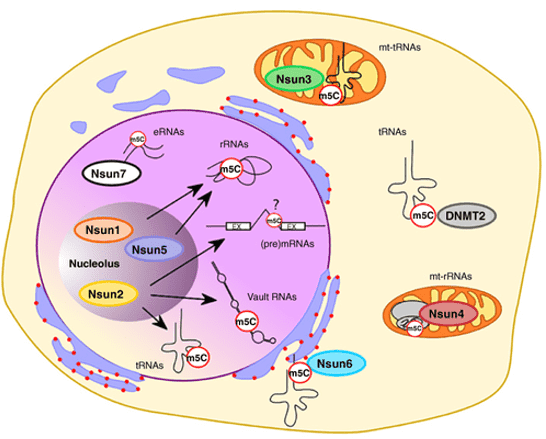Overview of Sequencing Methods for RNA m5C Profiling

Introduction to m5C in RNA
m5C is one of the most common and widespread RNA methylation modifications, found primarily in variable arms, anti-codon loops, and regions where rRNA binds tRNA to perform translation. Also dynamically reversible is RNA m5C modification. With S-adenosine methionine (SAM) as the donor, methyltransferase adds a methyl group to cytosine C, forming m5C. m5C can affect various stages of mRNA metabolism, including genome imprinting, retrotransposon silencing, transposition suppression, repetitive sequence suppression, and X chromosome inactivation, as a result of post-transcriptional methylation.

Figure 1. 5-methylcytosine is emerging as an important epitranscriptomic mark of RNA. Many if not most aspects of RNA metabolism may be affected by the m5C mark. (Trixl, 2019)
 Figure 2. Overview of the most commonly used existing techniques to map m5C in RNA. (Trixl, 2019)
Figure 2. Overview of the most commonly used existing techniques to map m5C in RNA. (Trixl, 2019)
hMeRIP Sequencing
hMeRIP sequencing is an antibody immunoprecipitation-based high-throughput sequencing method in which RNA-protein complexes are cross-linked for consistency and antibodies particular to hm5C are added. hMeRIP-seq, a new analysis technique for identifying hm5C modification, can analyze the distribution and changes of hm5C in the transcriptome in-depth, aiding researchers in better understanding the role of RNA modifications in life and disease, and promoting accurate disease diagnosis and treatment.
m5C-RIP Sequencing
Next-generation sequencing (NGS)-based 5-methylcytosine-RNA Immunoprecipitation (m5C-RIP) sequencing is a method for detecting m5C, one of the most common and abundant methylation modifications in the transcriptome. It can precisely investigate intercellular communication mechanisms and biomarkers for disease monitoring. RNA extraction, fragmentation, RNA immunoprecipitation, and library construction are all part of the procedure. The technology utilizes m5C-specific antibodies to enhance m5C-modified mRNAs from total mRNAs and integrates high-throughput sequencing technology and bioinformatics analysis to enable a genome-wide systematic search for m5C modification. m5C-RIP-seq has a higher specificity, enhances RNA modification detection, and accurately locates m5C sites. It enables researchers to delve deeper into epigenetics.
miCLIP-m5C-seq
MiCLIP-m5C-seq (m5C individual-nucleotide resolution crosslinking and immunoprecipitation sequencing) is a next-generation sequencing (NGS)-based method for detecting m5C, a common and abundant RNA methylation modification found in a variety of transcripts. In this method, ultraviolet light is used to cross-link mRNA with the m5C antibody, and the antibody cross-linked RNA fragment is purified and converted into a cDNA library. The circularized, re-linearized, amplified, and sequenced cDNA strand is then amplified and sequenced. The precise positions of m5C throughout the transcriptome are then determined by analyzing crosslink-induced mutations and truncations introduced during reverse transcription. MiCLIP-m5C-seq can precisely describe and quantify m5C, allowing researchers to gain a holistic understanding of organisms' growth and development, biological characteristics, and gene regulation mechanisms. It can be used in studies of disease mechanisms and biomarker screening in the field of disease research.
RNA Bisulfite Sequencing
RNA bisulfite sequencing (RNA BS-seq) is a next-generation sequencing (NGS) technique for detecting m5C and DNA methylation in the human transcriptome. Un-methylated cytosine is converted to uracil using sodium bisulfite, while methylated cytosine is left intact. This is followed by PCR amplification, library preparation, and next-generation sequencing. Finally, it can evaluate which nucleotide positions are methylated by comparing untreated and sodium bisulfite-treated sequences. RNA BS-seq is the gold standard method for methylation profile analysis because it can identify methylated cytosine with single-nucleotide resolution and full genome coverage. The RNA BS-seq can analyze the distribution and changes of m5C in the transcriptome in-depth, assisting researchers in better understanding the role of RNA modification in life and disease, and promoting accurate disease diagnosis and treatment.
References:
- Xue C, Zhao Y, Li L. Advances in RNA cytosine-5 methylation: detection, regulatory mechanisms, biological functions and links to cancer. Biomarker Research. 2020 Dec;8(1).
- Trixl L, Lusser A. The dynamic RNA modification 5‐methylcytosine and its emerging role as an epitranscriptomic mark. Wiley Interdisciplinary Reviews: RNA. 2019 Jan;10(1).
- Wei Z, Panneerdoss S, Timilsina S, et al. Topological characterization of human and mouse m5C Epitranscriptome revealed by bisulfite sequencing. International journal of genomics. 2018 Jun 13;2018.
- Questions and Answers
- Opinion
- Motivational and Inspiring Story
- Technology
- Live and Let live
- Focus
- Geopolitics
- Military-Arms/Equipment
- الحماية
- Economy
- Beasts of Nations
- Machine Tools-The “Mother Industry”
- Art
- Causes
- Crafts
- Dance
- Drinks
- Film/Movie
- Fitness
- Food
- الألعاب
- Gardening
- Health
- الرئيسية
- Literature
- Music
- Networking
- أخرى
- Party
- Religion
- Shopping
- Sports
- Theater
- Health and Wellness
- News
- Culture

